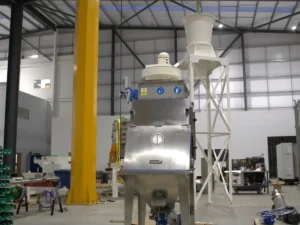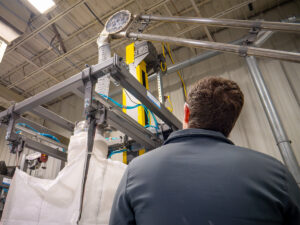There are 4 critical factors that must be considered to achieve acceptable bulk bag weighing accuracy:
- Consistent product flow: Any batch weighing application’s accuracy increases as the consistency of the product flow rate increases. This refers to the flow rate during a batch and from batch to batch. Bulk bag fillers typically have a weighing algorithm that includes an “in-flight offset” program that ‘learns’ when to stop product flow ahead of reaching the weight target to compensate for the product that is falling between the metering device and the bulk bag. The more consistent the flow the better the algorithm is able to fine-tune the system
- Metering device. Weighing accuracy is critically dependent on how well suited the metering device is to the application. A simple, two position gate valve may provide adequate accuracy when filling bulk bags with reasonably low bulk density product at a slow rate. However, when filling a high bulk density product at a high rate a conveyor/feeder may be required to achieve the desired accuracy. Note that the ultimate accuracy of a positive displacement type metering device (e.g. screw conveyor, screw feeder, rotary airlock, etc.) is limited to +/- the weight of product in one flight or pocket. Therefore, high bagging rate applications require great care in selecting the best metering system: a conveyor sized to provide a high flow rate necessary to achieve the desired bagging rate may not be able to produce adequate weighing accuracy because it is too large In that case, a different metering device, a second dribble feed device or a surge hopper with fast-acting gate valve may be required.
- Dead load. The weight that the weighing system sees before the product is added to the bulk bag is called the dead load. Gross weighing systems – those that weigh the entire bulk bag filler along with the product in the bag – can see a dead load of up to 2,000+ lb /900kg+ depending on the filler and its configuration. Bulk baggers that use hang weighing see a dead load equal to a few hundred pounds. This means the hang weighing filler can use smaller load cells or that the portion of the load cell span taken up by the dead load is much smaller. Either way, higher weighing resolution and more accurate weighing is the result.
- Weighing system minutiae. When filling bulk bags the specific type of load cell, controller/PLC resolution and scan time and the like are really not significant factors in achieving weighing accuracy. In my experience, any weight controller and PLC implementation have more than enough resolution to achieve the desired bulk bag weighing accuracy.
For more information on improving the accuracy of your bulk bags get in touch with one of our friendly and knowledgeable team and to learn about how accurate bulk bag filling can affect your bottom line read our blog post.






